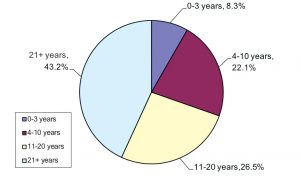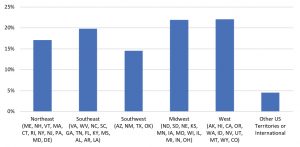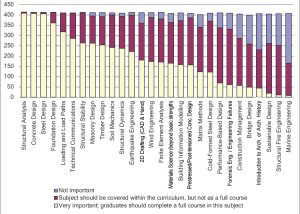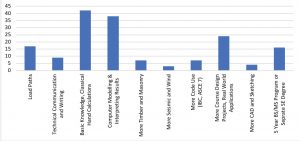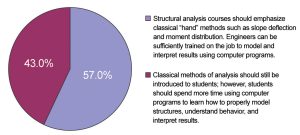The Basic Education Committee (BEC) launched two surveys in 2016 related to the National Council of Structural Engineers Associations (NCSEA) recommended curriculum:
- the Curriculum Survey, which canvassed colleges and universities to gauge course offerings (STRUCTURE, September 2016), and
- the Practitioner Survey, which targeted design professionals to better understand the skills necessary to enter the structural engineering profession.
The Practitioner Survey was administered via email and web links published in STRUCTURE and is summarized in this article.
Structural engineering firms have a vested interest in selecting new employees that possess the skills to be successful and that have an education that prepares them to solve technical issues. As a resource for structural engineering firms to better understand the education provided by universities, the Curriculum Survey was developed. This provided the “supply side” of the equation but lacked the “demand side.” What type of education do structural engineering firms desire and require of their new employees? The Practitioner Survey provided a resource to describe the skills and the educational requirements that structural engineering firms would like new employees to possess.
The Curriculum Survey focused on the 12 recommended core structural engineering courses offered at accredited engineering and engineering technology institutions. The current NCSEA BEC recommended structural engineering curriculum is as follows:
- Structural Analysis I
- Structural Analysis II
- Steel Design I
- Steel Design II
- Concrete Design I
- Concrete Design II
- Technical Writing
- Timber Design
- Masonry Design
- Matrix Methods
- Dynamic Behavior (including seismic)
- Foundation Design/Soil Mechanics
The Curriculum Survey showed that a few of the recommended courses were not readily offered, such as timber and masonry design.
As a follow-up to the Curriculum Survey, the Practitioner Survey was open to design professionals from September 2016 to December 2016 in the form of a web-based survey. Over 400 practitioners responded to the survey. These professionals ranged in experience from new graduates to seasoned engineers, as can be seen in Figure 1.
The geographic distribution of survey respondents was balanced between the Northeastern, Southeastern, Southwestern, Midwestern, and Western United States (Figure 2). Some respondents indicated their firm has multiple locations or their work is in multiple regions, and this was considered when evaluating the data. The committee presents this data to demonstrate that the results of the survey reflect opinions from across the country and that regional differences were not significant.
In the Practitioner Survey, the focus was on the education of the structural engineering student and how it relates to real-world applications, industry demand, and technical preparedness. In addition to addressing the core classes, the BEC sought feedback on technical and communication skills embedded in traditional coursework to gauge its importance and necessity in the workplace. Examples of evaluated skills are determining load paths, evaluating structural stability, and writing technical communications. Figure 3 shows the extent of the coursework and skills surveyed.
With the exception of matrix-methods coursework (at 85%), all core classes were viewed as a necessary component of a structural engineering student’s education. More than 90% of the practitioners responding indicated that the recommended curriculum topics should be included in, or are very important to, structural education.
The highest-ranked, non-core class or technical skill was loading and load paths. Technical skills are generally integrated into a group of design courses. A few institutions have courses dedicated to loading, load paths for members/elements, building systems, and connection details. The importance of this topic and how the BEC will address this in the recommended course curriculum is noted in the following.
The survey attempted to attract a distribution of respondents from across the structural engineering profession by practice work type, firm size, geographical region, and years of experience. The goal was to identify if these variables played a role in ranking the importance of topics for an education in structures. The results showed that these variables were not a differentiator for “most important topics” such as structural analysis, steel design, and concrete design, nor for lower ranked topics such as timber design and masonry design
(Figure 4). Additionally, the survey was successful in attracting a diverse sample of respondents. As expected, most respondents primarily work on buildings, which is consistent with the NCSEA membership.
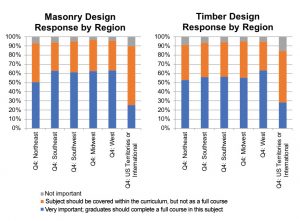
Figure 4. Practitioner response on the importance of subjects offered at colleges/universities by Region.
The Practitioner Survey provided insight through survey responses and from personal comments provided by the practitioners. In general, comments focused on how practitioners value the education of structural engineering students and what they view as important to sustaining their profession and business. Technical communications and writing skills were both strongly acknowledged in the survey responses, as well as the personal comments portion of the survey.
“Above all else, the structural engineering curricula should first address technical writing and communication skills” – practitioner
The chart shown in Figure 5 shows a distribution of personal responses that were categorized based on the context of the message. Most of the responses had strong views and opinions regarding the need for classical structural analysis methods, along with the use of computer modeling and interpreting results. Many practitioners also expressed the need for students to be involved with real-world applications, design projects, and introduction to full building design and load path analysis. Detailing, construction techniques, and understanding load paths were a common critique mentioned by respondents.
Likewise, many respondents (~43%) feel that basic knowledge and hand calculation methods are required; however, computer programming, modeling, and software is needed at the university level to complement students’ education (~57%). Figure 6 shows the actual response distribution from Question 6 on the survey. From the responses, it can be derived that structural analysis and classical methods should not leave the curriculum. However, from both Question 6 and the personal responses, understanding structural behavior and interpreting computer analysis results are also important.
The Practitioner Survey has highlighted, in our opinion, the need for students to bridge the gap between using computer models and successfully understanding and checking results. Furthermore, education of the structural engineering student is essential to the sustainability and safeguarding of the profession. Without proper training and knowledge, billable time is potentially affected along with concerns for public safety.
The BEC is currently working on a new Curriculum Survey with outcome-based questions that incorporate information gathered from prior curriculum surveys and the Practitioner Survey. It will be released in 2019 with the intent that trends can be identified. The Curriculum Survey will also attempt to address questions and responses from the 2016 questionnaires, such as the importance of wood, masonry, light gauge metal design, and structural behavior. These surveys aim to influence the education of structural engineering students, promote continuing education of the design professional, and identify the qualifications of entry-level engineers who will be the future leaders in the profession.
“Existing curricula is extremely deficient in the fields of engineered wood structures, CMU design, and cold-formed metal framing” – practitioner
Using the results from the Curriculum Survey and the Practitioner Survey, changes to the recommended curriculum may be forthcoming. It is the goal of the BEC to assess the results from the two surveys, administer a future student survey, then measure the effectiveness and adequacy of preparing structural engineers as technical leaders. A possible response is changing the recommended core curriculum. However, a curriculum change alone will not satisfy nor meet all needs of the profession, nor address the evolving nature of structural engineering. These courses are only one piece of the preparation, training, and skill requirements sought in graduating students by structural engineering firms. The survey responses help to define where additional training is sought and demanded by the structural engineering community.
Ultimately, the BEC would like the results of these surveys to be utilized by students, universities, and the structural engineering community. The surveys provide an avenue to better understanding educational requirements, raising awareness of the obstacles in providing the recommended curriculum, and, hopefully, inspiring the industry to support and augment student education.▪P

